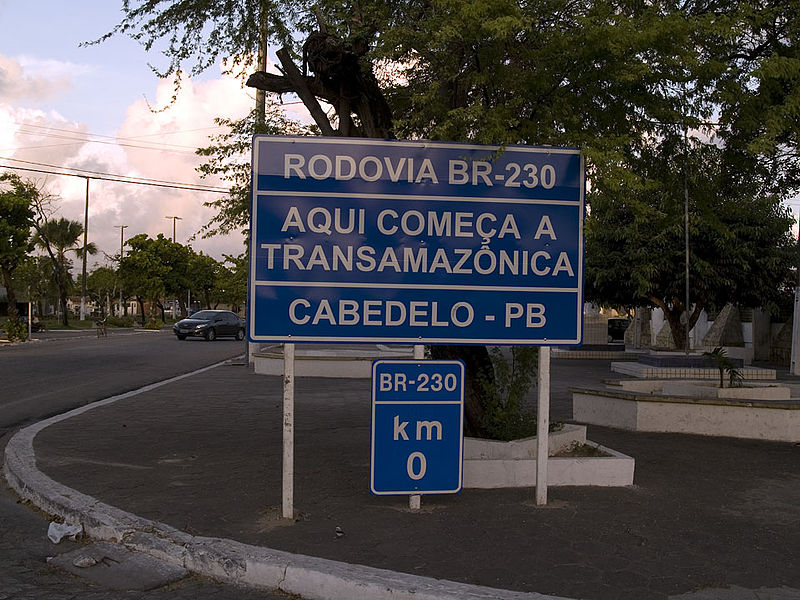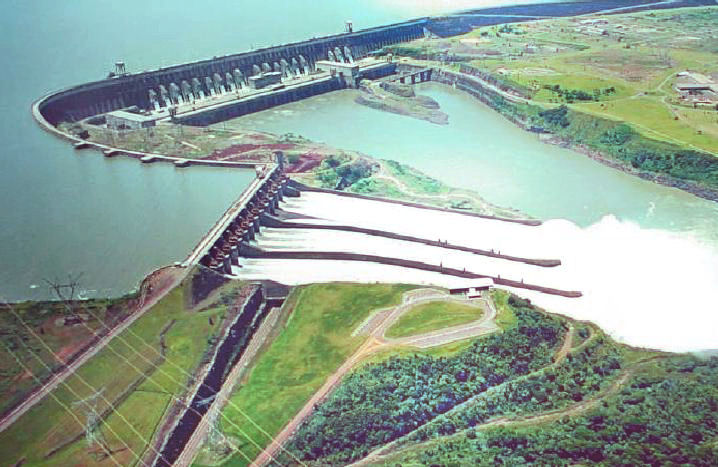
One of the major projects for economic growth in Brazil in the 1970s, the Transamazon Highway was meant to connect the northeast region of the country, suffering from a drought and generally less developed than the south, to unsettled land within the Amazon Rainforest where northeasterners could settle. However, due to the high costs of the project and the economic downturn toward the end of the decade, by the end of the 1970s only part of the highway was paved. It indirectly contributed to deforestation of the Amazon, allowing an easier route over which to transport lumber. From user Harmir74, courtesy of Wikimedia Commons.
Brazil’s highly precarious economic condition in 1964 demanded that the military renegotiate loan agreements and attract immediate financial support from foreign institutions, specifically the United States and the International Monetary Fund. Programs such as the Alliance for Progress, which gave aid to countries that could help the United States fight the spread of communism, guided Western bloc foreign policy, and so the military needed to assert its commitment to democratic processes and downplay allegations of authoritarian behavior in order to gain economic and political support in the West. Even after extra-legal institutional acts progressively weakened Brazilian democracy, the military refused to abandon claims that it favored democratic governance.
In language regarding the economy, the military’s emphasis on its preference for the free market and its disdain for statist intervention helped endear the regime to private capital and convinced Western nations of the generals’ anti-communist credentials, even though military policies did not consistently decrease state participation in the economy. Through the 1970s, the military government was engaged in large-scale development projects.

A graph demonstrates the steady growth of both gross national product and investment in industries during the early 1970s, followed by a gradual and then steep decline the next decade. From the Revista Brasileira de Economia.
The first order of business for the new regime was to diversify Brazil’s exports, encourage foreign investment, and implement tax incentives and currency devaluations to encourage overseas trade. At the same time, the military government began a push to raise tax collection, which resulted in a notable increase in tax revenue as a portion of the country’s gross domestic product. A growing imbalance of trade—between 1970 and 1973, exports grew 14.7 percent annually while imports grew 21 percent—was temporarily covered by a constant inflow of capital, investments from foreign governments, and private companies.
Equity in Economic Growth

As this graph shows, in the first decade of the dictatorship a great degree of wealth was concentrated in the highest 5 percent of the population, with almost half of the country having access to less than 10 percent of its resources. Data from Werner Baer, The Brazilian Economy 78.
President Juscelino Kubitschek’s plan for industrialization and economic growth in the 1950s had centered around production of, and presumably demand for, consumer durables—cars, refrigerators, air conditioners, and other relatively expensive household products. Demand for these items, which had only ever been present in a small portion of the population, dwindled in the 1960s, and, in the estimation of the military regime, the fastest way to stimulate the economy was to create demand for consumer durables.
This meant that government control of consumption in the early years of the coup focused on raising the purchasing power of those likely to buy such durables, or roughly the top 10 percent of the population. This was unsurprising, for any other strategy—anything that increased access to capital among the lower classes—could invite accusations of communism and undercut the military government’s carefully crafted image as a protector of the free market.
It was not only in growth incentives that the lower classes suffered. In strict anti-inflationary policy, implemented to meet the standards of the IMF, the Castelo Branco government had seriously limited industrial investment and allowed real wages, especially among workers, to drop.
While the regime earned praise for the favorable economic legacy left by its involvement—reducing inflation and improving the balance of payments with trading partners—the fact remained that vast swathes of the population did not feel the benefits of these “reforms” and in fact suffered from uneven growth. Economists Lance Taylor and Edmar Bacha termed the economy in the aftermath of the 1960s stabilitization attempts “Belindia”—Belgium in India. Brazil now had a top tier, with 20 percent of its population or roughly 22 million people enjoying relatively high per capita income, while the rest, 85 million people, lived at or below a subsistence level.
The Itaipu Project and International Perceptions of Growth
Despite persistent and widespread inequality, Brazil by the 1970s was perceived internationally to have a booming economy and tremendous influence over its neighbors. This foreign perception is evident in media coverage from the United States during the construction of Itaipu Binacional, currently the largest hydroelectric dam, in terms of generating energy, in the world.
Rapidly expanding and increasing its technological infrastructure by the 1970s, Brazil faced a severe power shortage and a dependence on foreign petroleum products that composed a majority of its imports at the time. A 1973 oil shock, in which the worldwide price of oil quadrupled, made Brazil’s need to produce petroleum domestically all the more acute.
In an effort to maximize its domestic resources, Brazil looked to the Paraná River. This river, however, lay on the border with Paraguay and had been a territory of regional dispute between the two countries since the 1800s; the region’s hydroelectric potential would not be exploited without either conflict or collaboration between them. The 1966 Treaty of Itaipu marked the first steps taken by Brazil and Paraguay to build what is now recognized as one of the Seven Wonders of the Modern World, Itaipu Binacional.
Views from abroad on the agreement between the two nations varied greatly. In general, sources in the United States presented Brazil’s push for growth as a threat to the rest of the continent, siding with Paraguay as the underdog:
With all these enormous benefits, the announcement of Itaipu has set off a wave of hope and speculation in this region.
But it has also caused…rumblings of discontent in Paraguay where many people say their country should have got a much better deal in the Brazil-Paraguay venture.
Moving fast and forcefully Brazil has overridden all objections and doubts.
For this country, time is short and there is no alternative to Itaipu, say government experts. In a few years, they explain, the south-central part of the country, including São Paulo, the largest industrial complex in Latin America and the fastest growing city in the world, will be desperately short of power. Only Itaipu can supply it on the scale it is needed (Greenwood, 1).
Brazil, which financed nearly the entire project, was also its primary beneficiary—while Paraguay had a legal right to 50 percent of the dam’s electrical output, the small country did not have nearly enough consumers or industry to use its entire share. According to a treaty agreed upon in 1973, the same year fluctuations in international oil prices made more domestic production a necessity in Brazil, that country had first priority in purchasing Paraguay’s excess power.
Future Reconsiderations
The growth of the Brazilian economy continued into the 1970s, and it was not until after a severe decline in the country’s GDP in the 1980s that many economists reconsidered the tactics used by the regime to achieve such growth. A high rate of private investment; infrastructural developments, the most massive and renowned of which was the Itaipu Dam; and an absence of major upheavals in the economy made the seventies seem, before later crises called that image into question, a truly miraculous time.
However, what was never in doubt—if it was also never readily visible, as it affected those outside the sphere of representation—was the effect of such growth on the lower 80 percent of wage earners. In particular, the rural poor, disconnected from centers of political power and the infrastructural developments that had been occurring, continued to suffer illiteracy and health problems, with few economic or political means of affecting change.
Throughout its regime, the military’s discourse carefully manipulated global tensions and “the communist threat” to endear itself to Western governments, financial institutions, and private capital and to strategically situate itself within the Western bloc. Rhetoric on domestic politics juxtaposed the military’s “counterrevolution” with the possibility of a communist revolution that would implement a totalitarian regime in Brazil. The economic miracle, though it was based on a high degree of government intervention and though it ultimately did not revolutionize the economy permanently, reinforced this image of the triumph of the free market over communism and anarchy.
Further Reading
- Werner Baer’s Industrialization and Economic Development in Brazil looks at the period that gave rise to many of the dictatorship’s justifications for economic policy, the years 1947–1961. He focuses on industrial development and its role in the economy’s rapid expansion.
Sources
- Baer, Werner. The Brazilian Economy: Growth and Development. Boulder, Colo. and London: Lynne Riener Publishers, 2008.
- Skidmore, Thomas. The Politics of Military Rule in Brazil, 1964–85. Oxford: Oxford University Press, 1988.
- Greenwood, Leonard. “Itaipu Dam in Brazil May Bring New Way of Life for S. America.” Los Angeles Times, 30 August 1973.
- Taylor, Lance and Edmar L. Bacha. “The Unequalizing Spiral: A First Growth Model for Belindia.” The Quarterly Journal of Economics 90:2 (May 1976).

